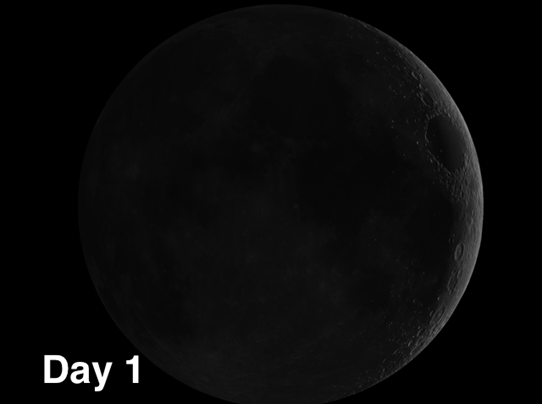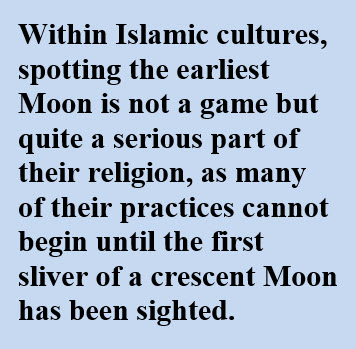The week of May 10-16 takes us from Lunar Day 28 to Day 5. This week we will highlight the craters Geminus and Burckhardt, viewable on Friday evening.
Geminus: [NE/F15] Roughly 200 miles north of Mare Crisium1, you will find the moderately complex 55-mile crater Geminus. It has terraced walls and small central peaks. This will give you an indication of what to start looking for in the following days as craters become increasingly more complex.
Burckhardt: [NE/F15; L=57°E] This is the crater with the “Mickey Mouse” ears. It is a remarkable exception to the rule that when one crater intrudes upon another, the younger crater (the intruder) is smaller. Burckhardt has landed smack in between two smaller but older craters, giving it the Mickey Mouse effect.
OF ADDITIONAL INTEREST IN SPACE THE WEEK OF MAY 10th:
 Because the Moon is so very low on the horizon, looking for features on Days 1 and 2 is really not worth the trouble. Wait until the first two days after full Moon when you can see these features to greater advantage. However, some astronomers play a game of trying to spot the earliest possible Moon with the naked eye. Although it’s fun to try this shortly after each new moon, the best times for this exercise is around April because the ecliptic (the apparent path of the Sun and planets against the starry background) is more perpendicular to the horizon. As a result, after the Sun sets, a closely trailing Moon will become visible in a dark sky more quickly than at other times in the year. After the Sun has set and twilight has begun, check out the area around the sunset point on the horizon for the Moon. If you don’t have any luck, scan the area with binoculars and if you can see a thin crescent try it with your naked eyes. Do not attempt this with binoculars until the Sun has completely set. Permanent eye damage may result if you accidentally view the sun through binoculars!
Because the Moon is so very low on the horizon, looking for features on Days 1 and 2 is really not worth the trouble. Wait until the first two days after full Moon when you can see these features to greater advantage. However, some astronomers play a game of trying to spot the earliest possible Moon with the naked eye. Although it’s fun to try this shortly after each new moon, the best times for this exercise is around April because the ecliptic (the apparent path of the Sun and planets against the starry background) is more perpendicular to the horizon. As a result, after the Sun sets, a closely trailing Moon will become visible in a dark sky more quickly than at other times in the year. After the Sun has set and twilight has begun, check out the area around the sunset point on the horizon for the Moon. If you don’t have any luck, scan the area with binoculars and if you can see a thin crescent try it with your naked eyes. Do not attempt this with binoculars until the Sun has completely set. Permanent eye damage may result if you accidentally view the sun through binoculars!
1 200 miles would be about three arc-minutes north of Crisium. Being familiar with the field of view (FOV) of your eyepieces will help you navigate.
======================
It is highly recommended that you get a copy of Sky and Telescope’s Field Map of the Moon, the very finest Moon map available for use at the telescope. It is available for $10.95 at www.skyandtelescope.com and on Amazon. All features mentioned in this blog will be keyed to the grid on the Field Map and will look like this: Plato: [NW/D9]
Credits:
Courtesy of Gray Photography of Corpus Christi, Texas
Lunar photos: NASA / USGS / BMDO / LROC / ASU / DLR / LOLA / Moon Globe. Used by permission
- Rupes Cauchy: A Best Known Fault on the Moon - July 22, 2024
- Moon Crater Schickard – Crater Floor has Stripes - July 15, 2024
- Moon Craters Langrenus and Vandelinus - July 8, 2024
